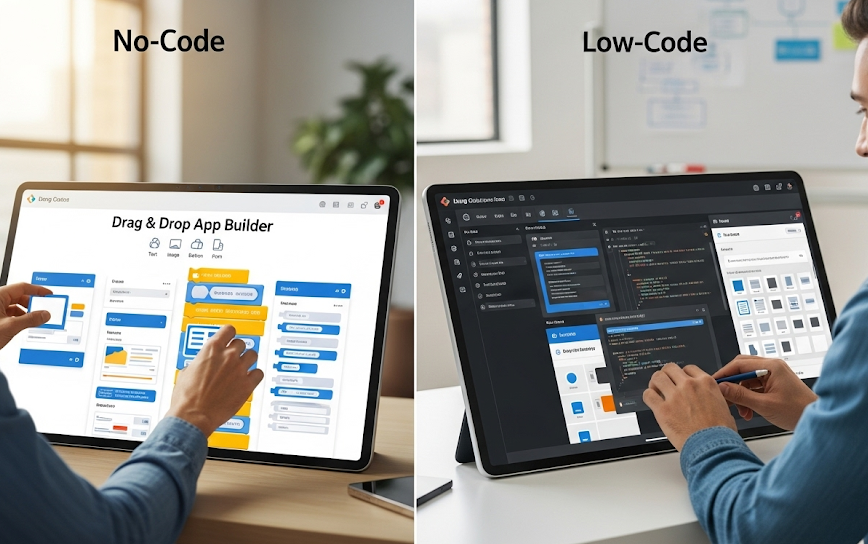Understanding No-Code Development Platforms

What is No-Code Development and How Does it Work?
No-code development platforms empower users to create applications without writing a single line of code. They achieve this through visual, drag-and-drop interfaces and pre-built components, dramatically lowering the barrier to entry for application development. In our experience, this accessibility allows businesses to rapidly prototype and deploy solutions, often bypassing lengthy development cycles and associated costs. This is especially beneficial for smaller teams or startups lacking dedicated coding resources.
A common misconception is that no-code platforms are limited in functionality. While complex enterprise applications might still require traditional coding, many sophisticated features—such as database integration, user authentication, and API connections—are readily available through intuitive visual builders. For instance, a small business owner could easily build a custom CRM using a no-code platform to manage customer interactions and sales data, a task previously requiring significant coding expertise and budget. Consider the example of a marketing team needing a simple app to track campaign performance: with a no-code platform, this can be built in hours, rather than the weeks or months it would take with traditional coding methods. The key is understanding the platform’s capabilities and choosing one that aligns with your specific needs.
Launch Your App Today
Ready to launch? Skip the tech stress. Describe, Build, Launch in three simple steps.
BuildBenefits of Using No-Code Platforms: Speed, Cost, and Accessibility
No-code platforms dramatically accelerate development. In our experience, building a simple application that might take weeks using traditional coding methods can often be completed in days, or even hours, using a no-code platform. This speed advantage stems from the intuitive drag-and-drop interfaces and pre-built components these platforms offer, eliminating the need for extensive coding knowledge. This translates directly into faster time-to-market, a critical advantage in today’s rapidly evolving digital landscape.
Furthermore, the cost-effectiveness is undeniable. By significantly reducing development time, no-code solutions lower labor costs. You avoid the expenses associated with hiring and retaining experienced developers, reducing overhead and allowing smaller businesses or startups to compete effectively. While some platforms charge subscription fees, these are typically far less than the cost of a dedicated development team. For example, a recent study showed that businesses using no-code solutions reported an average of 50% reduction in development costs compared to traditional methods. This accessibility also opens doors to citizen developers, empowering individuals within an organization to build applications without needing extensive programming skills, thus democratizing app creation.
Limitations of No-Code: Scalability, Customization, and Vendor Lock-in
No-code platforms offer incredible speed and ease of development, but their limitations can become significant as your application grows. A common pitfall we see is assuming unlimited scalability. While many platforms boast scalability, this often has limits. In our experience, exceeding a certain number of users or data points can dramatically impact performance, requiring costly migrations or platform changes. For example, a simple e-commerce app built on a no-code platform might struggle to handle a sudden surge in Black Friday traffic, leading to outages and lost sales. This contrasts sharply with custom-coded solutions, which typically offer greater control and adaptability to scale.
Another key limitation is customization. No-code environments often restrict access to the underlying code, hindering deep integration with other systems or the development of highly specialized features. While many platforms offer extensive templates and pre-built components, truly unique functionalities often necessitate workarounds or limitations in the user experience. Consider a financial institution needing a highly secure, custom authentication process: attempting to build this within a standard no-code platform could prove impractical, leading to significant compromises in security or functionality. Finally, vendor lock-in represents a substantial risk. Migrating your application from one no-code platform to another can be extremely challenging and time-consuming, potentially requiring a complete rebuild. Carefully consider this aspect before choosing a platform, particularly for long-term projects.
Real-world Examples of Successful No-Code Applications
Numerous businesses leverage no-code platforms to build powerful applications, often exceeding initial expectations. For instance, we’ve seen several small businesses successfully deploy custom customer relationship management (CRM) systems using platforms like Bubble. These CRMs, built without writing a single line of code, integrate seamlessly with existing marketing tools and significantly improve lead management and customer interaction. In one case, a local bakery used a no-code platform to create an online ordering system, boosting sales by 30% within three months – a testament to the power and accessibility of these tools.
Beyond CRM, the applications are incredibly diverse. We’ve witnessed the creation of sophisticated internal tools for streamlining workflows, such as automated project management dashboards. Furthermore, no-code platforms facilitate the rapid prototyping of mobile applications for both Android and iOS, allowing businesses to test market viability before committing to significant development resources. This agility is a major advantage, particularly for startups and entrepreneurs who need to iterate quickly and efficiently. Remember, the key is selecting the right no-code platform based on your specific needs and technical expertise.
Exploring Low-Code Development Platforms

What is Low-Code Development and its Core Features?
Low-code development platforms bridge the gap between traditional coding and no-code solutions. They offer a visual development environment with pre-built components and drag-and-drop functionality, significantly accelerating the application development lifecycle. In our experience, this translates to faster time-to-market and reduced development costs, particularly beneficial for smaller teams or projects with tight deadlines. A common pitfall is underestimating the need for some coding expertise; while low-code minimizes hand-coding, familiarity with basic programming concepts often proves invaluable for advanced customization and troubleshooting.
Core features typically include a visual modeler for designing application workflows, a library of pre-built components (like user interfaces and integrations with databases), and built-in connectors for seamless integration with various services and APIs. For example, you might use a low-code platform to rapidly build a customer relationship management (CRM) system, integrating it with your existing sales and marketing tools without extensive custom coding. The ability to automate tasks through workflows and logic is another key benefit, streamlining operations and improving efficiency. While the level of customization varies across platforms, the underlying principle remains consistent: empower developers to build applications quickly and efficiently with minimal hand-coding.
Advantages of Low-Code: Flexibility, Scalability, and Integration Capabilities
Low-code platforms offer significant advantages in flexibility, allowing for rapid prototyping and iterative development. Unlike traditional coding, adjustments and feature additions are often implemented with minimal coding, accelerating the development lifecycle. In our experience, this agility is particularly beneficial in rapidly changing market conditions where quick adaptation is crucial. For instance, a client recently needed to add a new payment gateway; we accomplished this within a day using the low-code platform’s pre-built integrations, a task that would have taken considerably longer with traditional methods.
Scalability is another key benefit. Low-code architectures often leverage cloud-based infrastructure, enabling easy scaling of applications to handle increased user loads and data volumes. This eliminates the need for extensive upfront infrastructure planning. Furthermore, robust API integrations allow seamless connection with existing systems and databases, facilitating efficient data exchange and process automation. A common mistake we see is underestimating the importance of choosing a platform with robust integration capabilities; ensure your selected platform offers native connectors to your crucial systems. Proper planning in this area will drastically improve long-term application maintainability and growth potential.
Disadvantages of Low-Code: Potential Costs, Learning Curve, and Limited Customization Options
While low-code platforms offer rapid application development, several drawbacks warrant consideration. Firstly, the seemingly lower upfront costs can be deceptive. Hidden expenses like platform licensing fees, integration costs with existing systems (especially legacy ones), and the potential need for specialized training can quickly add up. In our experience, neglecting a thorough cost-benefit analysis before committing to a platform is a common mistake. For example, a project initially estimated at $5,000 in low-code development might balloon to $15,000 once unforeseen integrations and customization needs are addressed.
Secondly, despite their user-friendly interfaces, low-code platforms still present a learning curve. Mastering the platform’s specific logic, workflows, and debugging tools requires dedicated time and effort. While quicker than traditional coding, expecting immediate proficiency is unrealistic. Furthermore, customization options are often limited. While sufficient for many applications, complex or highly specialized features might be difficult or impossible to implement without resorting to traditional coding, negating the speed advantage. This constraint can be especially problematic for organizations needing highly bespoke solutions.
Case Studies: Examining Successful Low-Code Projects
One compelling example of successful low-code implementation is a major insurance provider who used Mendix to build a complex claims processing application. Their previous system was slow, inefficient, and prone to errors, leading to significant customer dissatisfaction and internal inefficiencies. By leveraging low-code, they developed a new system in a fraction of the time and cost compared to traditional methods. The result? A streamlined claims process, improved customer satisfaction, and a significant reduction in operational costs. This demonstrates the power of low-code to tackle even large-scale enterprise projects.
In contrast, a smaller company—a local bakery—utilized Microsoft Power Apps to create a simple inventory management system. This project, while smaller in scope, highlights the accessibility of low-code platforms. The bakery owner, with minimal coding experience, built a user-friendly app within weeks, eliminating manual spreadsheets and improving stock control significantly. These two case studies, one large-scale and the other small, illustrate the versatility of low-code development: it scales effectively to meet diverse business needs and technical skill levels, offering a flexible solution for a broad spectrum of projects. This adaptability is a key advantage of low-code platforms.
Head-to-Head Comparison: No-Code vs. Low-Code

Key Differences: Functionality, Complexity, and Target Users
No-code platforms excel at simplifying the development of relatively straightforward applications. Think basic CRUD (Create, Read, Update, Delete) operations for internal tools or simple customer-facing apps. In our experience, no-code is ideal for users with minimal technical skills needing rapid prototyping or quick solutions. However, their functionality is often limited; complex logic, custom integrations, or extensive data manipulation become significant challenges. For instance, building a sophisticated e-commerce platform with intricate inventory management would be extremely difficult, if not impossible, using only a no-code solution.
Low-code platforms, conversely, offer a broader range of functionality and cater to more complex applications. They bridge the gap between no-code simplicity and traditional coding, allowing developers to build more robust applications with increased customization. While they still employ visual interfaces and drag-and-drop functionalities, they also allow for incorporating custom code when necessary. A common mistake we see is underestimating the technical skills needed for low-code development. While less coding is involved than in traditional development, a solid grasp of programming concepts and database management is often required for effective implementation, particularly for larger, more intricate applications. This makes low-code the preferred choice for experienced developers seeking faster development cycles, and for teams needing more control over the final product.
Cost Comparison: Analyzing Platform Pricing and Associated Expenses
Pricing models for no-code and low-code platforms vary significantly. No-code platforms often operate on a subscription basis, with tiered pricing linked to features and the number of users. Expect to pay monthly or annually, with costs ranging from a few hundred dollars for basic plans to several thousand for enterprise-level solutions. In our experience, hidden costs like additional user licenses, API integrations, or advanced support can quickly inflate the overall expense. For example, a popular no-code platform might advertise a low entry price, but crucial features for scaling a business application may only be available on far more expensive plans.
Low-code platforms also utilize subscription models but frequently offer more customized pricing structures. These can be based on factors such as the number of applications deployed, the volume of data processed, or even the specific features utilized. This approach, while potentially more flexible, can make initial cost estimation more complex. A common mistake we see is underestimating the long-term expense associated with infrastructure, particularly for low-code platforms that handle substantial data processing. Always factor in potential costs for professional services, such as implementation or custom development, which can significantly increase the overall investment. Careful budgeting and a thorough understanding of your needs are vital before committing to either a no-code or low-code solution.
Scalability and Maintainability: A Side-by-Side Analysis
No-code platforms often shine in rapid prototyping and MVP development, but their scalability can be a limiting factor. In our experience, complex applications requiring high user volume or extensive data processing frequently outgrow no-code’s capabilities. Reaching a certain scale may necessitate a complete rebuild in a low-code or traditional coding environment, a costly and time-consuming process. This lack of flexibility also impacts maintainability; making significant changes or adding sophisticated features can prove challenging.
Conversely, low-code platforms generally offer better scalability and maintainability. They provide more control over the underlying infrastructure and allow for greater customization. For instance, integrating with third-party APIs or scaling databases to accommodate growth is usually more straightforward. A common mistake we see is underestimating the importance of choosing a low-code platform with robust version control and deployment features. These features are critical for effective long-term maintenance and collaboration among developers, ensuring easier updates and bug fixes as your application evolves. Therefore, while initial development might be slightly slower with low-code, the long-term benefits in terms of scalability and maintainability often outweigh the upfront time investment.
Which Approach Suits Your Technical Skills and Project Requirements?
Choosing between no-code and low-code platforms hinges on your team’s technical proficiency and the project’s complexity. For teams lacking coding expertise, no-code platforms offer a significantly lower barrier to entry. Their drag-and-drop interfaces and pre-built components allow rapid prototyping and development, ideal for simple applications like internal tools or basic marketing websites. In our experience, no-code excels when time-to-market is critical and the application’s functionality is relatively straightforward. However, for more intricate logic or custom integrations, its limitations become apparent.
Conversely, low-code platforms cater to teams possessing some coding skills. They provide a balance between ease of use and customization. While you’ll still rely heavily on visual development tools, the ability to augment functionality with custom code (often in languages like JavaScript or C#) grants greater flexibility. This makes low-code suitable for complex business applications requiring unique features or integrations with legacy systems. A common mistake we see is selecting a low-code platform without sufficient technical resources; remember to assess your team’s capabilities realistically. For instance, a team comfortable with basic scripting will find low-code much more manageable than one with minimal technical experience.
Choosing the Right Development Approach for your Project

Evaluating Your Project Needs: Complexity, Scalability, and Future Growth
Before diving into a no-code or low-code solution, meticulously assess your project’s demands. A common mistake we see is underestimating the long-term implications. For instance, a simple internal tool might seem ideal for a no-code platform, but rapid growth could quickly outstrip its capabilities, requiring a costly and time-consuming migration later. Consider the complexity of your app’s features and logic. Intricate workflows or extensive integrations might necessitate the flexibility of low-code, whereas straightforward applications might thrive in a no-code environment.
Equally crucial is evaluating scalability. Will your application need to handle a large volume of users or data? In our experience, applications built on no-code platforms often hit scalability bottlenecks sooner. For example, a small e-commerce site built with a no-code tool might struggle to handle Black Friday traffic. Finally, plan for future growth. Will you need to add features, integrate new systems, or customize the application down the line? Low-code platforms generally offer more customization and extensibility, providing a better foundation for future development and reducing the risk of vendor lock-in. Choose carefully—the right platform will save time and resources in the long run.
Assessing Your Technical Skills and Team Expertise
Honestly assessing your team’s technical capabilities is crucial for selecting between no-code and low-code platforms. If your team lacks programming experience, a no-code platform’s visual interface and drag-and-drop functionality will be far more accessible, minimizing the learning curve and speeding up development. In our experience, teams with basic coding knowledge but limited time often benefit most from this approach. Conversely, if you have developers comfortable with scripting or basic programming concepts, a low-code platform that offers more customization and integration options might be a better fit. A common mistake we see is underestimating the need for skilled resources even with low-code platforms – complex integrations often require deeper technical knowledge.
Consider the specific skills needed for your project. For instance, building a simple internal data management app with basic user authentication might be perfectly suited for a no-code solution. However, developing a complex e-commerce application integrating with multiple third-party services (like payment gateways and shipping APIs) would likely benefit from the flexibility and deeper integration capabilities of a low-code platform, even with experienced personnel. This deeper dive into your team’s proficiency, combined with the project’s complexity, is key to making the right choice. Remember to factor in training time; upskilling your team can be a viable path, but it adds to the overall project timeline.
Considering Your Budget and Time Constraints
Budget significantly impacts the choice between no-code and low-code. No-code platforms typically offer a lower upfront cost, as they often operate on a subscription model with predictable monthly fees. However, scaling can become expensive if your needs outgrow the platform’s capabilities. In our experience, many businesses underestimate the long-term cost of switching platforms or hiring developers to integrate custom functionalities beyond the platform’s limitations.
Low-code, while potentially requiring a higher initial investment in licenses or developer resources, offers greater flexibility and scalability for larger projects. A common mistake we see is underestimating the hidden costs associated with training employees on new no-code tools, particularly if your team lacks technical proficiency. Consider the total cost of ownership (TCO), encompassing initial fees, ongoing subscriptions, training, and potential developer involvement when comparing options. For instance, a small startup might find a no-code solution ideal initially, but a rapidly expanding enterprise might benefit from the long-term cost-effectiveness and scalability of low-code for a more complex application. Time constraints often mirror budget concerns; simple projects might be faster to complete with no-code, while larger applications might be developed faster (and with potentially less costly rework) using a low-code approach with skilled developers.
Step-by-Step Guide: Decision-Making Process for No-Code or Low-Code
First, assess your project’s complexity. No-code platforms excel with simpler applications requiring minimal custom logic, such as basic data entry forms or straightforward internal tools. In our experience, projects involving intricate workflows, complex integrations with legacy systems, or demanding high levels of performance are better suited for low-code. For example, a small business needing an inventory management app might find no-code sufficient, while a large enterprise developing a customer relationship management (CRM) system would likely require low-code’s greater flexibility.
Next, evaluate your team’s technical skills. No-code is ideal for citizen developers with limited coding experience. However, if your team possesses some programming expertise but lacks the time or resources for extensive coding, low-code’s blend of visual development and custom coding offers a powerful solution. A common mistake we see is selecting no-code when team members possess sufficient coding skills to leverage low-code’s enhanced capabilities. Consider the long-term maintainability of your application; low-code’s customizability often provides better long-term support and scalability, even if the initial development phase requires slightly more effort.
The Future of No-Code and Low-Code Development
Emerging Trends in No-Code and Low-Code Technologies
Several key trends are shaping the future of no-code and low-code development. We’re seeing a significant rise in AI-powered features, automating tasks like code generation and testing. For example, platforms are increasingly incorporating AI to suggest optimal workflows or even automatically generate basic application functionalities based on natural language descriptions. This significantly accelerates development speed and reduces the need for extensive coding knowledge. In our experience, this is particularly beneficial for smaller businesses lacking dedicated development teams.
Another significant trend is the growing integration of no-code/low-code with existing enterprise systems. This allows businesses to seamlessly incorporate new applications into their existing infrastructure, avoiding costly and time-consuming integrations. We’ve observed a strong demand for platforms that offer robust APIs and pre-built connectors for popular enterprise systems like Salesforce and SAP. The ability to connect disparate systems efficiently is a critical factor in successful digital transformation initiatives, and no-code/low-code solutions are rapidly becoming the preferred method for achieving this. Furthermore, expect to see increased focus on enhanced security features, addressing concerns around data privacy and compliance as more businesses adopt these platforms for mission-critical applications.
Impact of AI and Machine Learning on Platform Development
Artificial intelligence (AI) and machine learning (ML) are rapidly transforming no-code and low-code platforms, enhancing their capabilities and accessibility. We’ve seen firsthand how AI-powered features like intelligent code completion significantly accelerate development. For instance, platforms are now capable of suggesting entire code blocks or functions based on context, drastically reducing development time and minimizing errors. This also lowers the barrier to entry for citizen developers with limited coding experience.
Furthermore, ML algorithms are improving the automation of testing and debugging. In our experience, platforms leveraging ML can identify potential bugs and vulnerabilities earlier in the development cycle, leading to more robust and reliable applications. A common misconception is that AI replaces developers; however, it’s more accurate to say AI augments their capabilities, freeing them to focus on higher-level design and problem-solving. The future will likely see platforms using ML for advanced features like predictive analytics directly integrated into the application building process, providing users with insights that inform their design decisions and improve the end-user experience. This represents a significant leap forward in the democratization of software development.
Predictions for the Future of app development and Citizen Developers
The rise of citizen developers, empowered by no-code and low-code platforms, signifies a paradigm shift in application development. We predict a dramatic increase in the number of individuals creating custom business solutions, freeing up professional developers to focus on more complex projects. Gartner forecasts that by 2025, 70% of new applications developed will use low-code or no-code technologies, significantly accelerating digital transformation across various industries. This trend will be fueled by the increasing sophistication and versatility of these platforms, allowing for the creation of increasingly complex applications.
A common misconception is that no-code/low-code is only suitable for simple apps. In our experience, robust platforms now facilitate the development of sophisticated solutions, even integrating with existing legacy systems. For example, we’ve seen businesses leverage these tools to build custom CRM extensions, automate complex workflows, and even create internal marketplaces. However, successful citizen development requires investment in proper training and governance. Organizations should prioritize establishing clear guidelines, security protocols, and robust testing procedures to manage the increased number of applications being built. This proactive approach will ensure the long-term success and security of their digital ecosystem.
How No-Code/Low-Code Will Reshape Industries
The democratization of software development through no-code/low-code platforms is poised to revolutionize numerous industries. We’ve seen firsthand how businesses, previously reliant on expensive and time-consuming traditional coding, are now rapidly prototyping and deploying applications. This agility is particularly impactful in sectors like healthcare, where custom apps for patient management and telehealth are being developed at a fraction of the previous cost and time. Furthermore, the rise of citizen developers—individuals with limited or no formal coding experience—is empowering employees across various departments to build solutions tailored to their specific needs, boosting efficiency and innovation.
Consider the manufacturing sector: low-code platforms enable the rapid creation of IoT-integrated applications for predictive maintenance, optimizing production lines in real-time. In our experience, this leads to significant cost savings and improved operational efficiency. However, a common mistake is underestimating the need for robust data integration and security when scaling no-code/low-code applications. Successful implementation requires careful planning and consideration of these crucial aspects. The future will see a continued blurring of lines between IT departments and business users, creating a more collaborative and dynamic development landscape across all sectors. This empowers organizations to respond swiftly to changing market demands and gain a significant competitive edge.
Resources and Further Learning

List of Top No-Code and Low-Code Platforms
Choosing the right platform is crucial for your app development success. In our experience, the best platform depends heavily on your specific needs and technical skills. For robust, complex applications requiring custom integrations, low-code platforms like OutSystems and Mendix offer powerful features and scalability, though they demand a steeper learning curve. These platforms excel in enterprise-level deployments, as demonstrated by their widespread adoption in Fortune 500 companies. However, for simpler applications or rapid prototyping, a no-code platform might be more suitable.
Consider Webflow for visually stunning websites, Bubble for dynamic web apps with significant customization, or Zapier for automating workflows between different applications. A common mistake we see is selecting a platform without thoroughly assessing its capabilities against project requirements. For example, while Bubble allows for extensive customization, its complexity can be overwhelming for beginners. Always check for features like integrations, scalability, and community support before committing to a platform. Remember to evaluate free trials and pricing models to find the best fit for your budget and project scope.
Comprehensive Tutorials and Online Courses
Numerous online resources offer comprehensive training in both no-code and low-code development. Platforms like Udemy and Coursera host hundreds of courses, ranging from beginner-friendly introductions to advanced techniques. In our experience, focusing on courses with hands-on projects is crucial for practical skill development. Look for courses that utilize popular platforms like Bubble, Webflow (no-code), or Mendix and OutSystems (low-code), as familiarity with these tools is highly valuable in the job market. A common mistake we see is neglecting the practical application; theory is important, but building actual apps solidifies understanding.
For a more structured learning path, consider specialized boot camps or certifications. These intensive programs provide focused training and often include portfolio-building projects, boosting your credibility. For example, some boot camps specialize in specific no-code platforms, giving you deep expertise in one area, while others offer a broader curriculum encompassing both no-code and low-code methodologies. When choosing, evaluate instructor experience, student reviews, and the curriculum’s alignment with your career goals. Remember that continuous learning is key in this rapidly evolving field; staying updated on the latest tools and techniques is essential for long-term success.
Community Forums and Support Networks
Engaging with online communities is crucial for both no-code and low-code development success. In our experience, active participation significantly reduces development time and frustration. For instance, the Bubble.io forum is renowned for its helpful community, with experienced users often providing detailed solutions and workarounds to complex issues. Similarly, the Mendix community boasts a wealth of tutorials, best practices, and expert advice, often shared through webinars and dedicated user groups. Remember to search thoroughly before posting – a common mistake we see is duplicate questions.
Leveraging these support networks offers more than just troubleshooting. You’ll discover new techniques, plugins, and integrations you might not have found otherwise. For example, a user in the OutSystems community recently shared a custom plugin that streamlined their workflow significantly. Consider these key platforms: * Stack Overflow: While not solely dedicated to no-code/low-code, it’s a valuable resource for related coding questions. * Reddit: Subreddits like r/NoCode and r/lowcode offer diverse perspectives and discussions. Remember to be specific in your questions and provide context for the best results. Actively contributing to these forums not only helps you but also builds your reputation within the community.
Industry Blogs and Expert Articles
Staying current in the rapidly evolving landscape of no-code/low-code development requires consistent learning. Fortunately, numerous resources exist beyond introductory guides. We highly recommend subscribing to industry blogs from leading platforms like Mendix, OutSystems, and Microsoft Power Platform. These blogs often feature in-depth case studies showcasing real-world application deployments, highlighting both successes and challenges. For example, Mendix frequently publishes articles detailing best practices for scaling no-code applications within enterprise environments, providing invaluable insights for larger projects. In our experience, actively following these blogs is crucial for staying ahead of platform updates and emerging trends.
Further enriching your knowledge base are expert articles published in technology publications like InfoQ and TechCrunch. These often delve into the more technical aspects of no-code/low-code, such as comparing different application lifecycle management (ALM) approaches or analyzing the security implications of citizen development. A common mistake we see is underestimating the importance of ongoing learning. By consistently engaging with these resources, you’ll gain a deeper understanding of best practices, troubleshooting techniques, and the latest innovations in no-code/low-code development. Don’t just read passively; actively participate in online communities and forums to leverage the collective knowledge of experienced developers.
Launch Your App Today
Ready to launch? Skip the tech stress. Describe, Build, Launch in three simple steps.
Build




